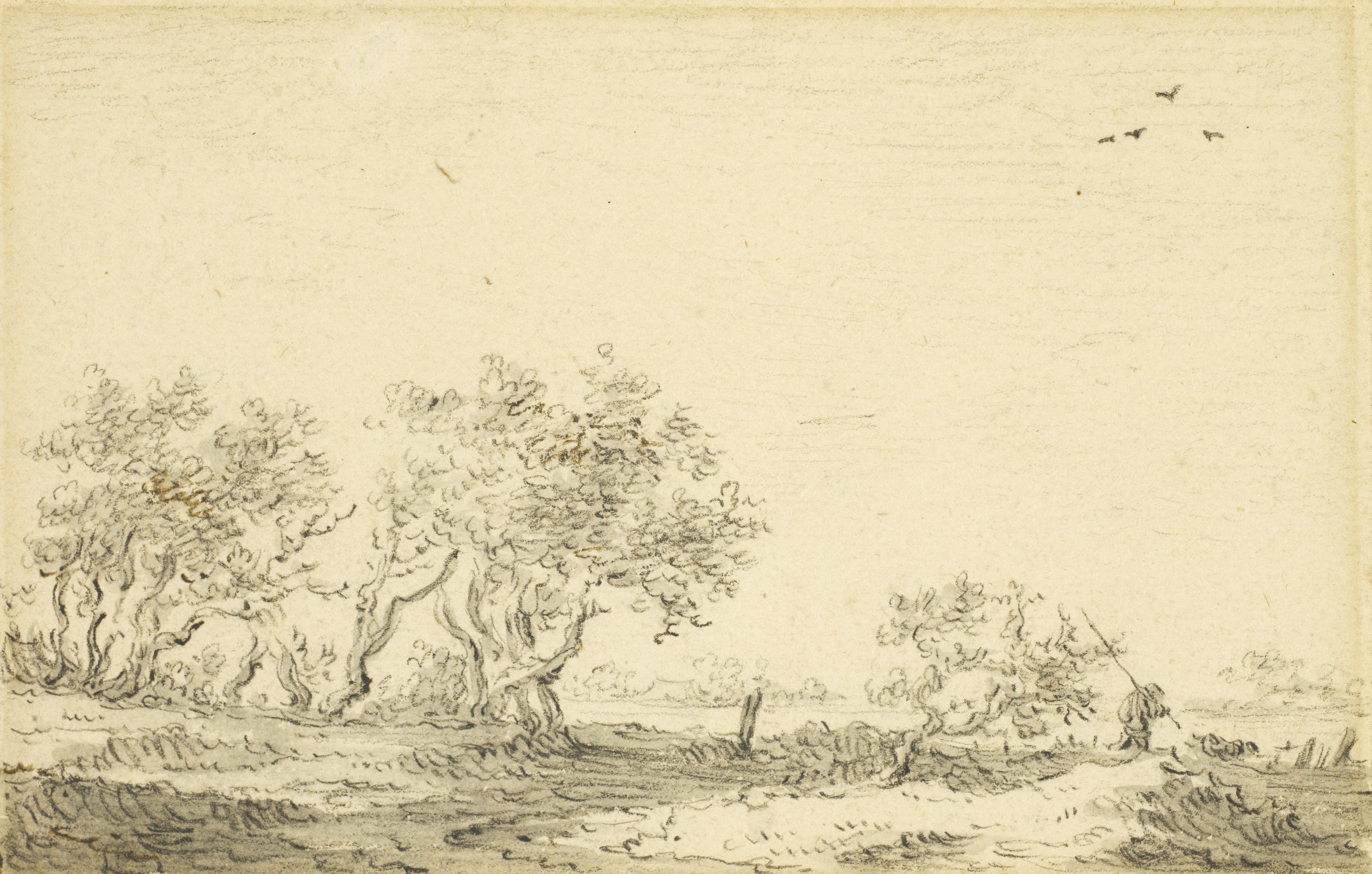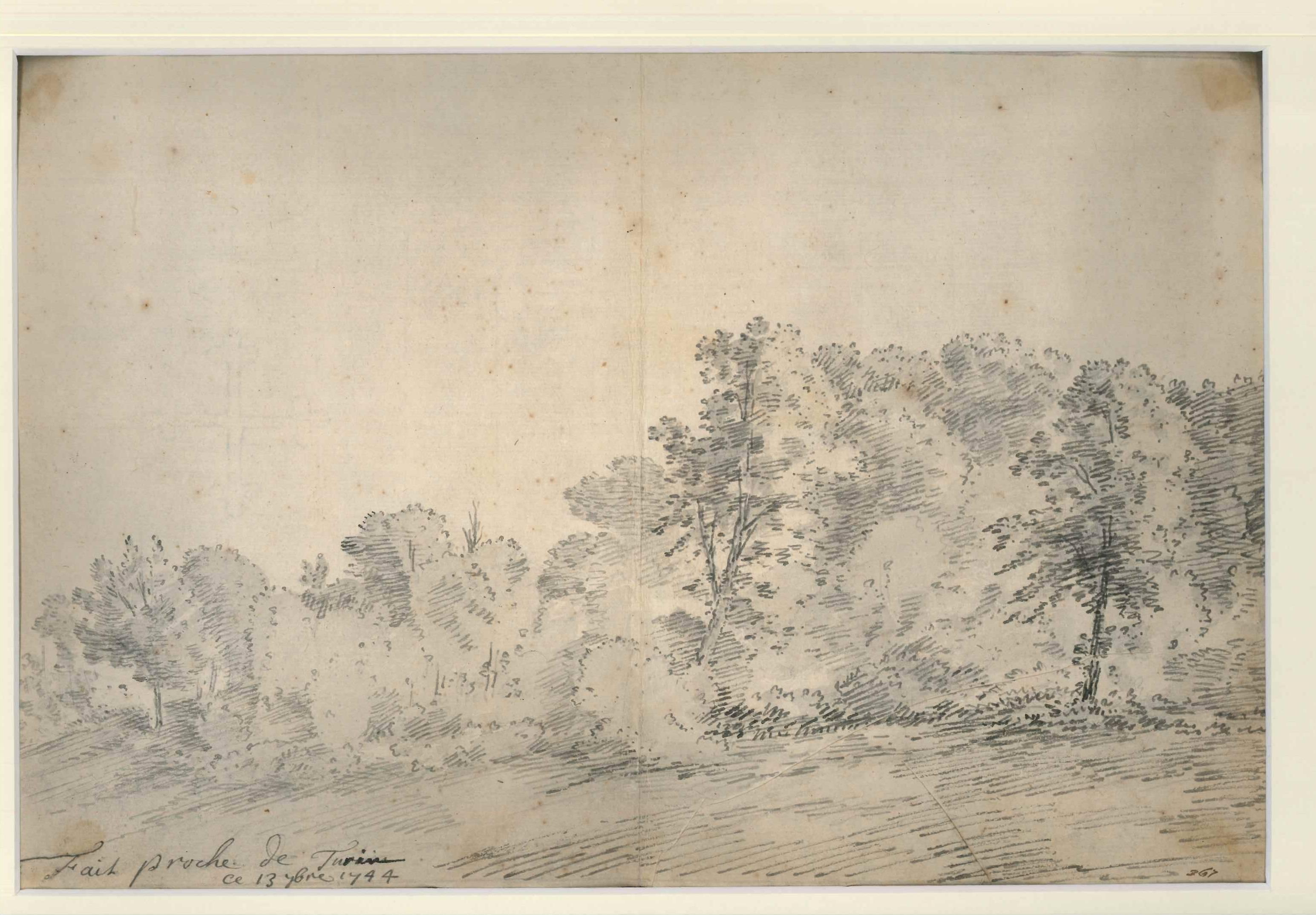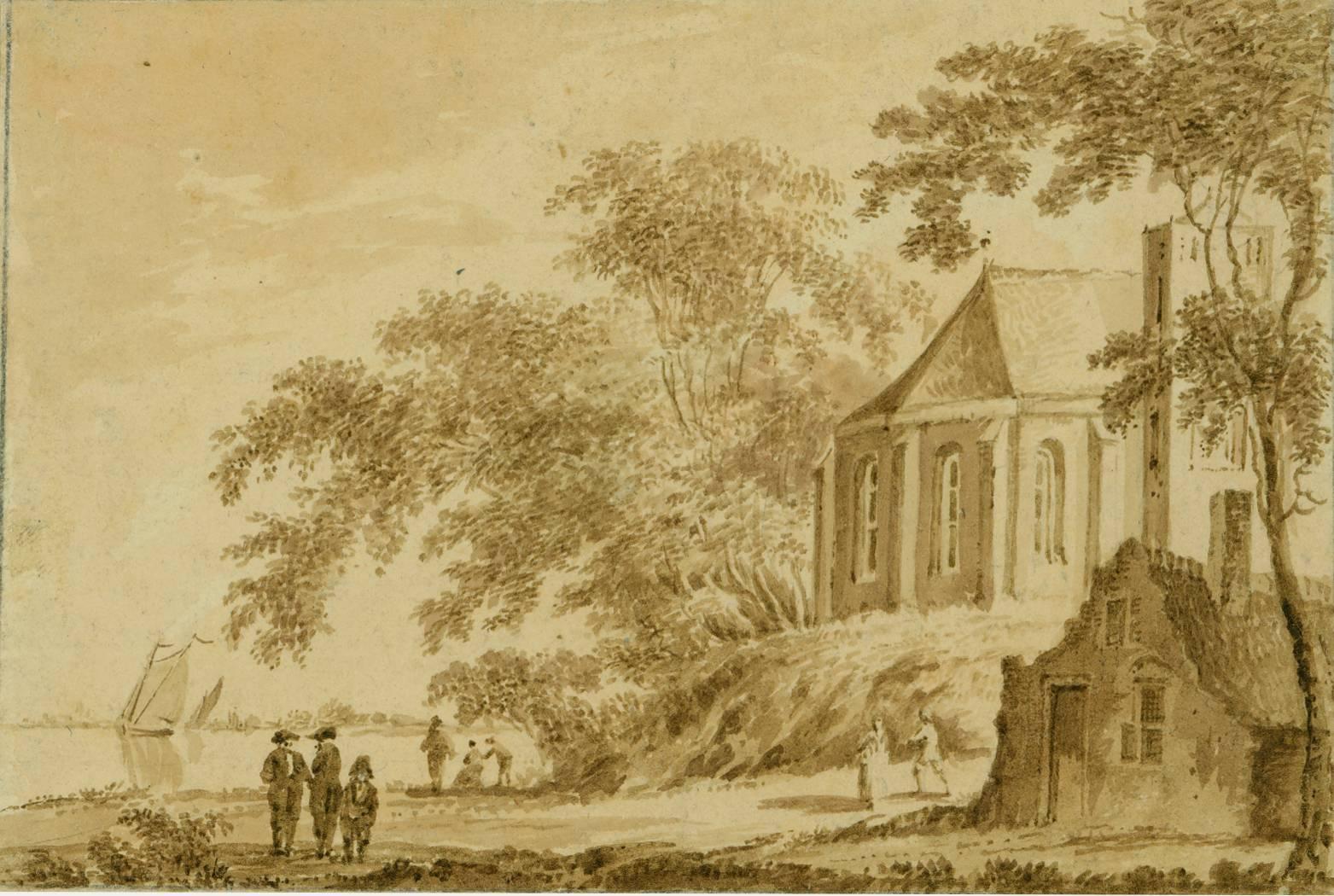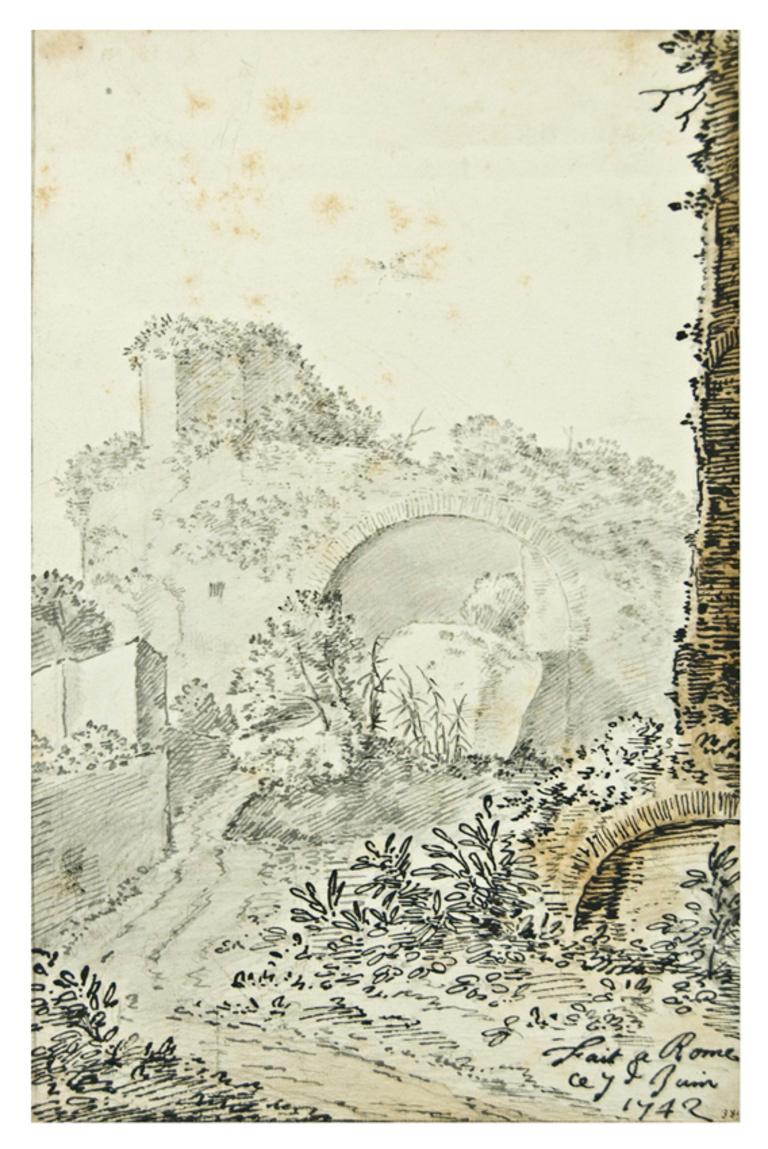Items Similar to A Windmill above an Arched Bridge, at left a Quay Wall
Want more images or videos?
Request additional images or videos from the seller
1 of 2
Jan Josefsz Van GoyenA Windmill above an Arched Bridge, at left a Quay Wall1651
1651
About the Item
Inscribed “159” in the upper right
Provenance:
(Possibly) The Van Goyen sketchbook which in 1845 belonged to Andrew Geddes, A.R.A. (1783-1844), London; his sale, Christie's, London, April 8-14, 1845, lot 361.
The sketchbook bought on the continent in the 19th century by Johnson Neale (a friend of the father of Mr. T. Mark Hovell);
Mr. T. Mark Hovell, F.R.C.S., London, by June 1918;
Thomas Dinwiddy; his sale, Sotheby's, London, July 3-4, 1918, lot 124 (the entire album, £610, to Colnaghi and Obach);
with P. and D. Colnaghi & Co., London (stock no. A1700);
to Frederik Muller & Cie., perhaps as agent for Anton Wilhelmus Mari Mensing, 15 August 1918, for £800.
Anton Wilhelmus Mari Mensing (1866-1936), who dismembered the album; his sale, Frederik Muller & Cie., Amsterdam, April 27-29, 1937, lot 218 (7,200 florins, to “Hirschmann”);
A. Mayer, the Hague and New York;
Dr. Karl Lilienfeld, New York, by 1957, who dispersed the album;
Frederick Mont, New York, by 1964 -1994; thence by descent until 2018.
Exhibited:
The Hague, Maurithuis, 1895. (the entire sketchbook)
The Hague, Maurtishuis, 1918. (the entire sketchbook)
“Jan Van Goyen,” Leiden, Stedelijk Museum, 4 June-27 July 1960, Arnhem, Gemeentemuseum, 31 July-26 September 1960, no. 107 (according to an inscription on the reverse; one of five sheets lent by Van-Diemen-Lilienfeld Galleries)
Literature:
Verslagen omtrent ’s Rijks Verzamelingen van Geschiedenis en Kunst, Vol. 18, 1895-96, p. 64-66.
Campbell Dodgson, “A Dutch Sketchbook of 1650,” Burlington Magazine, Vol. 32, No. 183 (June 1918), pp. 234-240. (the entire sketchbook)
Campbell Dodgson, “A Dutch Sketchbook of 1650,” Burlington Magazine, Vol. 33, No. 186, (September 1918), p. 112. (the entire sketchbook)
Campbell Dodgson, “A Dutch Sketchbook of 1650,” Burlington Magazine, Vol. 66, No. 387 (June 1935), p. 284. (the entire sketchbook)
Friedrich Gorissen, Conspectus Cliviae, Kleve, 1964, p. 84-86.
Hans-Ulrich Beck, “Jan Van Goyen am Deichbruch von Houtewael (1651),” Oud Holland, Vol. 81, no. 1 (1966), p. 21, footnote 10, as one of the Amsterdam sketches, ‘Mühle am Wall’ (“mill on the wall”).
Hans-Ulrich Beck, Ein Skizzenbuch von Jan van Goyen, The Hague, 1966, p. 5. (the entire sketchbook)
Hans-Ulrich Beck, Jan van Goyen, 1596-1656: Ein Oeuvreverzeichnis, vol. 1, “Katalog der Handzeichnungen,” Amsterdam, 1972, p. 306, no. 847/159, unillustrated.
This charming drawing of a view outside Amsterdam was drawn from life by one of the leading seventeenth-century Dutch landscape artists, Jan van Goyen. Van Goyen was born in Leiden and received his first artistic training there, later studying with Esaias van de Velde for a year in Haarlem (1617-1618). He was an extremely prolific painter and draughtsman, capturing the scenic topography of the Dutch landscape in oil and in chalk.
Van Goyen travelled through the Low Countries at various times throughout his career, documenting his trips with drawings in sketchbooks. This sheet derives from a sketchbook that he used in 1650-1651 on a trip along the Rhine River, during which he visited these the cities of Arnhem, Emmerich, Cleves, Nijmegen, and Tiel. After returning to the Hague, the city where had established himself, he filled the remainder of the sketchbook with drawing made on shorter trips. This particular drawing dates from Van Goyen’s trip to Amsterdam, where he recorded the devastation caused by the breaching of the Stain Anthonis Dike near Houtewael on 5 March 1651.
The drawing depicts a windmill flanked by chimneys, which each rise above an arched bride in the center of the sheet. There is a quay wall at left that sits along the water in the foreground. The small, quickly described object to the right of the bridge may be a representation of a small boat floating on the water. The drawing is freely executed in black chalk and worked up with a grey wash, possibly applied later when Van Goyen had returned to his studio. Van Goyen here captures a compositionally interesting view that unfolds along a gentle diagonal from the upper left to the lower right, interrupted by the prominent windmill. Van Goyen frequently revisited the swift and spontaneous drawings that he recorded in this sketchbook while in the studio, incorporating the landscape views in paintings or using them as the basis for more elaborate, finished drawings. However, the view in this drawing does not appear in any known painting or drawing by the artist.
The early provenance of the 1650-1651 sketchbook is not entirely clear. It is likely that it belonged to Andrew Geddes in the early 19th-century, but the first notice of the sketchbook dates from when it was exhibited at the Mauritshuis in 1895. The sketchbook was independently attributed to Van Goyen by Campbell Dodgson, Cornelis Hofstede De Groot, and Abraham Bredius in the early twentieth-century. It remained integral, with some sheets already removed, until it reached the collection of the dealer Anton Mensing, who removed the drawings from their binding and mounted them on individual mats. The sheets were kept together and sold as a group from Mensing’s collection, and were later dispersed by the dealer Karl Lilienfield, who acquired them in 1957. According to an inscription on the reverse of the frame, the present drawing was one of the five sheets lent by Lilienfeld to the 1960 Jan Van Goyen exhibition in Leiden and Arnheim.
- Creator:Jan Josefsz Van Goyen (1596 - 1656, Dutch)
- Creation Year:1651
- Dimensions:Height: 3.88 in (9.86 cm)Width: 6.13 in (15.58 cm)
- Medium:
- Movement & Style:
- Period:1650-1659
- Condition:
- Gallery Location:New York, NY
- Reference Number:1stDibs: LU1029637392

About the Seller
5.0
Recognized Seller
These prestigious sellers are industry leaders and represent the highest echelon for item quality and design.
Established in 1997
1stDibs seller since 2012
17 sales on 1stDibs
Typical response time: 11 hours
- ShippingRetrieving quote...Ships From: New York, NY
- Return PolicyThis item cannot be returned.
More From This SellerView All
- A Musical PartyBy German SchoolLocated in New York, NYProvenance: Dr. George Hamilton, Massachusetts; and by descent. Private Collection, Ohio, until 2021. Exhibited: (Possibly) Clark Art Institute, Massachusetts (according to a handwritten inscription on the reverse). This drawing by an anonymous, 16th-century German hand presents a delightful scene of nymphs—mostly nude but some draped with cloth—making music in an outdoor setting. The composition is executed within a roundel and centers on the harpsichord played by the figure seen from behind. She is accompanied by a host of other instruments, including horns, a harp, and a lira da gamba played by figures gathered nearby, several of which are positioned along the curved edges of the visual field. Two satyrs observe the merrymaking—one leans on the harpsichord while the other holds aloft a cup, presumably of wine, adding a bacchic element to the revelry. The drawing was previously owned by Dr. George Hamilton, scholar of modern art and Director of the Sterling and Francine Clark Art Institute in Williamstown (1966–1977). Hamilton played...Category
16th Century Old Masters Landscape Drawings and Watercolors
MaterialsPaper, Ink, Pen
- Study of a Franciscan Saint, probably San Diego de AlcaláLocated in New York, NYProvenance: Ivan E. Phillips, Montreal and New York, until 2023. The brothers Bartolomé Carducho and Vicente Carducho, both born and trained in Florence, settled in Spain where they made their careers. Vicente worked on numerous commissions for both the church and the Spanish court...Category
17th Century Old Masters Drawings and Watercolor Paintings
MaterialsPaper, Chalk, Ink, Pen
- The Flight into EgyptLocated in New York, NYInscribed: 3. una Madonna che va in Egitto, verso, and Madonna che va in Egitto, recto Provenance: Private Collection, UK, since 1999 This expressive and boldly executed drawing is the work of Luca...Category
16th Century Old Masters Figurative Drawings and Watercolors
MaterialsChalk, Ink, Pen, Paper
- The Martyrdom of the Santi Quattro CoronatiLocated in New York, NYProvenance: Private Collection, UK After initial training under Justus Suttermans and Vincenzo Dandini, in 1673 Anton Domenico Gabbiani embar...Category
17th Century Old Masters Figurative Drawings and Watercolors
MaterialsPaper, Chalk, Ink, Pen
- The 1564 Medici Danti Map of CaliforniaBy Fra Egnazio DantiLocated in New York, NYFlorentine, Probably Seventeenth Century Titled L’ultime parti note nel Indie occidentali Dated on the edge of the cartouche: “M.D. LXIII. M.AG” [1564…the month of August] In the 1560s Cosimo I de’Medici, the powerful Duke of Florence, undertook a major renovation of the Palazzo Vecchio, the venerable palace that to this day dominates the city at the Piazza della Signoria. For the Sala della Guardaroba, literally the wardrobe room, but in fact the storeroom of the Duke’s most precious holdings, Cosimo conceived of a grand decorative project that was to reflect in one space the entire cosmos --both an indication of the Duke’s ambition and an allusion to his name. The plan, supervised by Giorgio Vasari, involved the construction of walnut cabinets to contain the Medici treasures, on the outside doors of which were to be placed large hand-painted maps specially commissioned to document and illustrate the current knowledge of the world. Portraits of famous men were to decorate the tops of the cabinets and two large globes –one representing the terrestrial world, the other celestial—were to descend from openings in the ceiling. The commission for the maps, inspired by Ptolemy’s Geographia, was given to the celebrated mathematician and cosmographer, Fra Egnazio Danti (Perugia 1536-1585 Alatri). Fifty-three maps were ultimately created. Thirty were conceived and executed by Danti between 1563 and 1575. The remaining twenty-three were completed by Stefano Bonsignori between 1576 and 1686. They remain in place in Florence in the room for which they were created. The present work is an exact-size painted, drawn and inscribed copy of Danti’s map of California...Category
17th Century Old Masters Drawings and Watercolor Paintings
MaterialsCanvas, Paper, Ink, Watercolor, Gouache, Pen
- Study after Michelangelo’s “The Last Judgment”By Michelangelo BuonarrotiLocated in New York, NYItalian School, 16th Century Provenance: Private Collection, New York This intriguing drawing is a study by an anonymous 16th-century Italian artist after a vignette in Michelangelo’s fresco of The Last Judgement in the Sistine Chapel. The altar wall of the Sistine Chapel was already richly decorated when Pope Clement VII commissioned Michelangelo to paint his Last Judgment...Category
16th Century Old Masters Figurative Drawings and Watercolors
MaterialsPaper, Gouache
You May Also Like
- Landscape with Trees and a Fisherman walking, a drawing by Jan Van GoyenBy Jan Josefsz Van GoyenLocated in PARIS, FRNo Dutch draughtsman ever captured the atmosphere of the rural countryside of Holland with the same atmospheric and engaging simplicity that Van Goyen achieved in drawings such as this. Indeed, his landscapes were seminal in the development of the genre. The present sketch conveys a striking sense of movement within the natural landscape, conveyed by the deftly applied strokes of chalk, from which the artist’s hand can be sensed. The composition is characteristic of his work, with the low horizon affording significance to the broad sky and the soaring birds within. This feeling of windswept motion powerfully evokes the expansive Dutch farmland with which he was evidently preoccupied. 1. Jan van Goyen...Category
1650s Old Masters Landscape Drawings and Watercolors
MaterialsChalk, Ink, Laid Paper
- Turin Countryside - Original Ink and Watercolor by Jan Pieter Verdussen - 1744By Jan Pieter VerdussenLocated in Roma, ITChina ink and Watercolour. With handwritten notes, indicating the place and date of the artwork in lower margin: "Fait proche de Turin, ce 13 Juin 1744". Numbered on the lower right ...Category
1740s Old Masters Landscape Drawings and Watercolors
MaterialsPaper, Ink, Watercolor
- Pavilion with waterfall, an ink wash attributed to Hubert Robert (1733 - 1808)By Hubert RobertLocated in PARIS, FRThis large wash drawing is a slightly enlarged version of a composition executed by Hubert Robert in 1761, at the end of his stay in Rome. This composition is a marvellous synthesis of the painter's art: the clatter of the waterfall, in a grandiose setting inspired by antiquity, is opposed to the intimacy of a genre scene, made up of a few peasant women performing some agricultural work. 1. The stay in Italy, an important founding stage in Hubert Robert's carrier Hubert Robert came from a privileged family of Lorraine origin, linked to the Choiseul-Stainville family, where his father was an intendant. The protection of this powerful aristocratic family enabled him to study classical art at the Collège de Navarre (between 1745 and 1751). After a first apprenticeship in the workshop of the sculptor Slodtz (1705 - 1764), he was invited by Etienne-François de Choiseul-Beaupré-Stainville (the future Duke of Choiseul, then Count of Stainville) to join him in Rome when the latter had just been appointed ambassador. Hubert Robert arrived in Rome on 4 November 1754, aged twenty-one, and remained there until 24 July 1765. Thanks to his patron, he obtained a place as a pensioneer at the Académie de France without having won the prestigious Prix de Rome. On his arrival in Rome, he frequented the studio of the painter Giovanni Paolo Panini (1691 - 1765), the inventor of the ruins painting, and also benefited from the proximity of Giovanni Battista Piranesi’s studio (1720 - 1778). During his eleven-year stay in Rome, Hubert Robert studied the great Italian masters and drew many of the great archaeological sites, multiplying the sketches which he would use throughout his career, becoming one of the masters of the "ruin landscape". Back in Paris in 1765, he was very successful. He was accepted and admitted to the Royal Academy of Painting and Sculpture on the same day, July 26th 1766, which was very unusual. He was appointed draughtsman of the king's gardens in 1784, then guard of the Royal Museum from 1784 to 1792. Arrested in 1793 and detained in the prisons of Sainte Pélagie and Saint-Lazare, he was released in 1794 after the fall of Robespierre and undertook a second trip to Italy. In 1800, Hubert Robert was appointed curator of the new Central Museum and died at his home in Paris in 1808. 2. Description of the artwork This composition, formerly called "La Cascade du Belvédère Pamphile" , is undoubtedly inspired by the water theatres of the Frascati villas. Hubert Robert presents a hemicycle of columns with rustic bossages at the foot of which is a cascade of water falls into a basin. The hemicycle is flanked by two high walls, pierced by window wells topped with antique masks...Category
1760s Old Masters Landscape Drawings and Watercolors
MaterialsInk, Watercolor
- View of the KagermeerBy Hendrick V. TavernierLocated in Storrs, CTInk and watercolor on paper. 3 1/2 x 5 1/4. Unsigned. Excellent condition on cream laid paper, tipped onto a backing sheet at the top corners. Annotated "Tavernier" verso, and "Hendr...Category
Late 19th Century Old Masters Landscape Drawings and Watercolors
MaterialsInk, Watercolor
- La Campagne de Rome - Roman Countryside - Drawing by J. P. Verdussen - 1740caBy Jan Peeter VerdussenLocated in Roma, ITChina ink and watercolour on paper. Realized in 1740 ca. Very good conditions. Includes passepartout.Category
1740s Old Masters Figurative Drawings and Watercolors
MaterialsWatercolor, Ink
- Ruines Romanes - Roman Ruins - Ink and Watercolor by J. P. Verdussen - 1742By Jan Peeter VerdussenLocated in Roma, ITChina ink and watercolor on paper. Hand dated. Conditions: Foxing on the top right of the paperCategory
1740s Old Masters Figurative Drawings and Watercolors
MaterialsWatercolor, Ink
Recently Viewed
View AllMore Ways To Browse
Moment In Time
Original Portrait Paintings
Vintage New Years Art
Vintage Photography Color
Used Open Sign
Early 21st Century
Vintage Portrait Prints
American Still Life
James And James
City Landscape Paintings
Printed Animal
Second Time
Vintage Number Stamp
Vintage Number Stamps
French Vintage Prints
Animal Print
Vintage Paris Print
4 X 4 Frame





